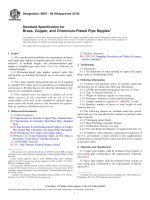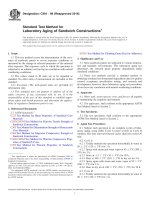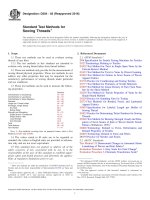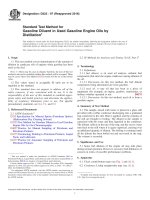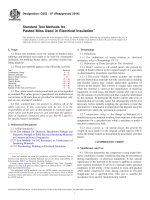Astm d 4899 99 (2016)
Bạn đang xem bản rút gọn của tài liệu. Xem và tải ngay bản đầy đủ của tài liệu tại đây (79.45 KB, 2 trang )
Designation: D4899 − 99 (Reapproved 2016)
Standard Practice for
Analysis of Vegetable Tanning Materials—General1
This standard is issued under the fixed designation D4899; the number immediately following the designation indicates the year of
original adoption or, in the case of revision, the year of last revision. A number in parentheses indicates the year of last reapproval. A
superscript epsilon (´) indicates an editorial change since the last revision or reapproval.
D6405 Practice for Extraction of Tannins from Raw and
Spent Materials
D6406 Test Method for Analysis of Sugar in Vegetable
Tanning Materials
D6407 Test Method for Analysis of Iron and Copper in
Vegetable Tanning Materials
D6408 Test Method for Analysis of Tannery Liquors
D6409 Practice for Color Tests with Sheepskin Skiver
D6410 Test Method for Determining Acidity of Vegetable
Tanning Liquors
1. Scope
1.1 This practice is intended for use in the chemical analysis
of all vegetable tanning materials.
1.2 The values stated in SI units are to be regarded as
standard. No other units of measurement are included in this
standard.
1.3 This standard does not purport to address all of the
safety concerns, if any, associated with its use. It is the
responsibility of the user of this standard to establish appropriate safety and health practices and determine the applicability of regulatory limitations prior to use.
2.2 ALCA Methods:
A1 Analysis of Vegetable Tanning Materials—General3
A5 Extraction of Raw and Spent Materials3
A6 Moisture in Raw and Spent Materials3
A10 Preparation of Solution of Liquid Extracts3
A11 Preparation of Solution of Solid, Pasty, and Powdered
Extracts3
A12 Cooling of Analytical Solutions3
A13 Evaporation and Drying of Analytical Solutions3
A20 Total Solids and Water3
A21 Soluble Solids and Insolubles3
A22 Non-Tannins and Tannin3
A25 Analysis of Tannery Liquors3
A30 Sugar in Tanning Materials3
A31 Copper and Iron in Tanning Materials3
A40 Color Tests with Sheepskin Skiver3
A50 Lignosulfates (Sulfite Cellulose)3
A60 Official Certification3
J10 Sampling of Vegetable Materials Containing Tannin3
2. Referenced Documents
2.1 ASTM Standards:2
D4900 Test Method for Lignosulfonates (Sulfite Cellulose)
in Tanning Extracts
D4901 Practice for Preparation of Solution of Liquid Vegetable Tannin Extracts
D4902 Test Method for Evaporation and Drying of Analytical Solutions
D4903 Test Method for Total Solids and Water in Vegetable
Tanning Material Extracts
D4904 Practice for Cooling of Analytical Solutions
D4905 Practice for Preparation of Solution of Solid, Pasty
and Powdered Vegetable Tannin Extracts
D6401 Test Method for Determining Non-Tannins and Tannin in Extracts of Vegetable Tanning Materials
D6402 Test Method for Determining Soluble Solids and
Insolubles in Extracts of Vegetable Tanning Materials
D6403 Test Method for Determining Moisture in Raw and
Spent Materials
D6404 Practice for Sampling Vegetable Materials Containing Tannin
2.3 Federal Specification
DD-V-582 Volumetric Apparatus, Glass4
3. Significance and Use
3.1 Vegetable tanning materials are natural products containing various substances of varying composition, concentration and quality.
1
This practice is under the jurisdiction of ASTM Committee D31 on Leather and
is the direct responsibility of Subcommittee D31.01 on Vegetable Leather. This
practice has been adapted from and is a replacement for Method A1 of the Official
Methods of the American Leather Chemists Association.
Current edition approved Sept. 1, 2016. Published September 2016. Originally
approved in 1989. Last previous edition approved in 2009 as D4899–99 (2009).
DOI: 10.1520/D4899-99R16.
2
For referenced ASTM standards, visit the ASTM website, www.astm.org, or
contact ASTM Customer Service at For Annual Book of ASTM
Standards volume information, refer to the standard’s Document Summary page on
the ASTM website.
3
Official Methods of the American Leather Chemists Association. Available
from the American Leather Chemists Association (ALCA), University of Cincinnati,
P.O. Box 210014, Cincinnati, OH 45221–0014.
4
Available from Standardization Documents Order Desk, Bldg. 4 Section D, 700
Robbins Ave., Philadelphia, PA 19111-5094, Attn: NPODS.
Copyright © ASTM International, 100 Barr Harbor Drive, PO Box C700, West Conshohocken, PA 19428-2959. United States
1
D4899 − 99 (2016)
5.4 General laboratory apparatus and reagents shall be
available. (Special apparatus and reagents are described in the
individual methods.)
3.2 The methods referenced are useful for analyzing and
testing vegetable tanning materials for moisture, waterextractable substances, cold-soluble fractions, tannins, nontannins, acidity, tanning properties, the color of tanned leather,
and the presence or absence of certain admixtures.
6. Procedure
6.1 Cover all funnels, collecting dishes, and other apparatus
used during the analysis so as to prevent, or reduce to a
minimum, any change in the concentration of solutions by
evaporation of water.
6.2 Measure all aliquots of analytical solutions, pipetted for
the determination of total solids, soluble solids, non-tannins, or
other, at the same temperature within the range 23° to 25°C as
specified in ALCA Methods A21 and A22.
4. Samples and Specimens
4.1 The preparation of the composite sample of a vegetable
tanning material for analysis purposes shall be as described in
ALCA Method J10.
5. Apparatus and Reagents
5.1 All volumetric glassware shall comply with Federal
Specification DD-V-582.
7. General Analytical Procedure for the Analysis of
Vegetable Tanning Materials
7.1 The following ASTM standards are applicable: Test
Methods D4900, D4902, D4903, D6401, D6402, D6403,
D6406, D6407, D6408, and D6410, and Practices D4901,
D4904, D4905, D6404, D6405, and D6409.
5.2 Unless otherwise specified, all reagents used in the
chemical analyses shall be of certified ACS purity grade and
comply with the specifications recommended by the Committee on Analytical Reagents of the American Chemical Society.5
5.3 The distilled water used in the chemical analysis shall
have a pH of not less than 5.5, nor more than 7.0, and shall give
a residue of not more than 0.0005 g when 100 mL is evaporated
and dried in a platinum dish.
7.2 The following ALCA Methods are applicable: A5, A6,
A10, A11, A12, A13, A20, A21, A22, A25, A30, A31, A40,
A50, A60, J10.
8. Keywords
5
8.1 tannin; tannin analysis; vegetable tannin analysis; vegetable tannins
American Chemical Society, 1155 16th St. NW, Washington, DC 20036.
ASTM International takes no position respecting the validity of any patent rights asserted in connection with any item mentioned
in this standard. Users of this standard are expressly advised that determination of the validity of any such patent rights, and the risk
of infringement of such rights, are entirely their own responsibility.
This standard is subject to revision at any time by the responsible technical committee and must be reviewed every five years and
if not revised, either reapproved or withdrawn. Your comments are invited either for revision of this standard or for additional standards
and should be addressed to ASTM International Headquarters. Your comments will receive careful consideration at a meeting of the
responsible technical committee, which you may attend. If you feel that your comments have not received a fair hearing you should
make your views known to the ASTM Committee on Standards, at the address shown below.
This standard is copyrighted by ASTM International, 100 Barr Harbor Drive, PO Box C700, West Conshohocken, PA 19428-2959,
United States. Individual reprints (single or multiple copies) of this standard may be obtained by contacting ASTM at the above
address or at 610-832-9585 (phone), 610-832-9555 (fax), or (e-mail); or through the ASTM website
(www.astm.org). Permission rights to photocopy the standard may also be secured from the Copyright Clearance Center, 222
Rosewood Drive, Danvers, MA 01923, Tel: (978) 646-2600; />
2
